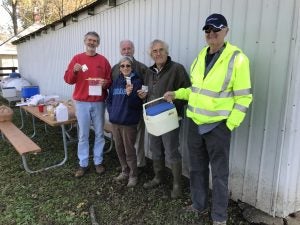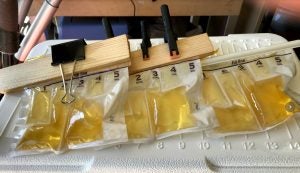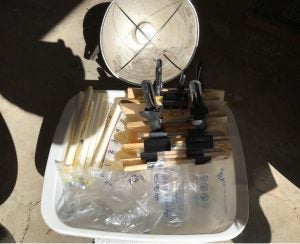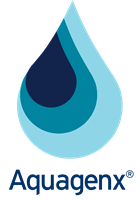Salt River Watershed Watch is a group of citizens who volunteer to monitor streams, rivers and springs in the Salt River Watershed in Kentucky, USA. Volunteers are trained to collect water quality samples from streams and rivers. A science background or previous experience are not required. www.srww.org
Problem
Salt River Watershed Watch (SRWW) is a volunteer group of citizen scientists that is funded by grants and donations. Volunteers collect water samples three times per year and test for pH, temperature, dissolved oxygen conductivity and E. coli bacteria. Previously, E. coli samples were sent to a local lab for analysis and test results. Despite discounts given by the lab, it is a struggle for SRWW to obtain funding for lab testing of watersheds draining to sample sites when problems were discovered. In addition, SRWW found elevated levels of bacteria in Clear Creek, which includes access to a water trail, parks and canoe launches. These are valuable resources for the community, however the elevated bacteria levels detected by SRWW presented a public health challenge.
Solution
SRWW incorporated the Aquagenx CBT E. coli Kit into their program so they can do water quality testing for E. coli themselves, on-site and without a lab. A group of six volunteers was trained to use the CBT Kit.
They used the CBT Kit at 10 sites along Clear Creek, upstream of the canoe launch and at the volunteer monitoring site at Red Orchard Park. Three samples were collected in October 2018 at each of the 10 sites. Volunteers incubated CBT samples, and some samples were also delivered to a lab in Louisville, Kentucky for E. coli analysis using IDEXX Colilert.
SRWW partnered with Watershed Watch in Kentucky, Virginia Environmental Endowment and Microbac Laboratories. SRWW made a presentation to the Watershed Watch in Kentucky (WWKY) Board of Directors. WWKY is SRWW’s parent organization. They approved funding from their Virginia Environmental Endowment grant to purchase the Aquagenx CBT Kit, supplies and lab costs for comparative testing.
Test Results
E. coli test results from the 30 water quality samples from 10 sites ranged from 30 to greater than 2,000 MPN /100 mL. From the study, SRWW discovered elevated bacteria is a widespread problem in the mainstem of Clear Creek and the tributaries they sampled. A map of SRWW’s test results can be seen here.
Comparison of the CBT E. coli Kit to IDEXX Colilert
Comparisons between the Aquagenx CBT Kit and IDEXX Colilert standard methods in the lab were very favorable, reports SRWW. For two sample runs, SRWW used a 1:10 dilution with the CBT Kit. As a result, several CBT samples had E. coli above 1,000 MPN /100 mL. For the third sample run, they used a 1:20 dilution (5 mL sample). Of 34 samples, 78% of CBT Kit diluted samples were in the same bacteria category (i.e., low, medium, high) as Colilert. SRWW considered this a success.
Conclusion
Karen Schaffer, Science Adviser, Salt River Watershed Watch says, “A major advantage of the CBT Kit is many of our volunteers test stream sites that are not near the lab. We have a system of runners who meet volunteers and bring samples to the lab. The CBT Kit eliminates the need for runners delivering samples to the lab to meet bacteria holding times. Another big advantage is cost. The CBT Kit cost per test is half or less than half the cost of lab testing.””
Schaffer continues, “We are expanding our use of the CBT Kit to other basin groups. Samples will be collected by Four Rivers, Kentucky and Salt River Watershed Watch groups. The CBT Kit really improves and simplifies our ongoing water quality monitoring and is a great tool for our volunteers.”






